For roughly five years now or so, I’ve been putting out a series of articles taking a look at late-draft dart throw players, guys who aren’t going in most mid- or late-rounds but going super late in the draft (if they’re drafted at all).
Every guy listed in my article from back in March had an NFBC ADP of 250 or higher, meaning these were guys in your 10- and 12-team leagues going way late in drafts who I believed were worthy of a late grab given their potential ceilings. And if they didn’t pan out, you could easily drop them without it really hurting your team all that much.
For the past few years, I’ve decided to take a look back at how those dart throws panned out, so let’s dig into it again!
Final season stats: .279/.335/.524, 18 HR, 62 R, 56 RBI, 7 SB
Byron Buxton was technically an honorable mention on my dart throws article since his ADP was just shy of 250, but I included him anyways cause why not.
The hope with drafting Buxton later in drafts this year was that you could attempt to get the ceiling of Buxton that we’ve all known exists without having to pay a premium like you have in the past.
There were even reports out of spring training that Buxton was healthy and that he wanted to steal 30 bases, so hey, why not take a shot?
Ultimately, I think Buxton probably helped your team more than hurt. He played in 102 games, which believe it or not is a career-best, and he maintained a pretty good average throughout the season with some solid power (those 30 steals didn’t happen but I mean, I don’t think any of us really expected they would).
Buxton didn’t make the best decisions at the plate, but that process got better as the season went on and, as you can see in the chart, the power was very much there while Buxton was out there:
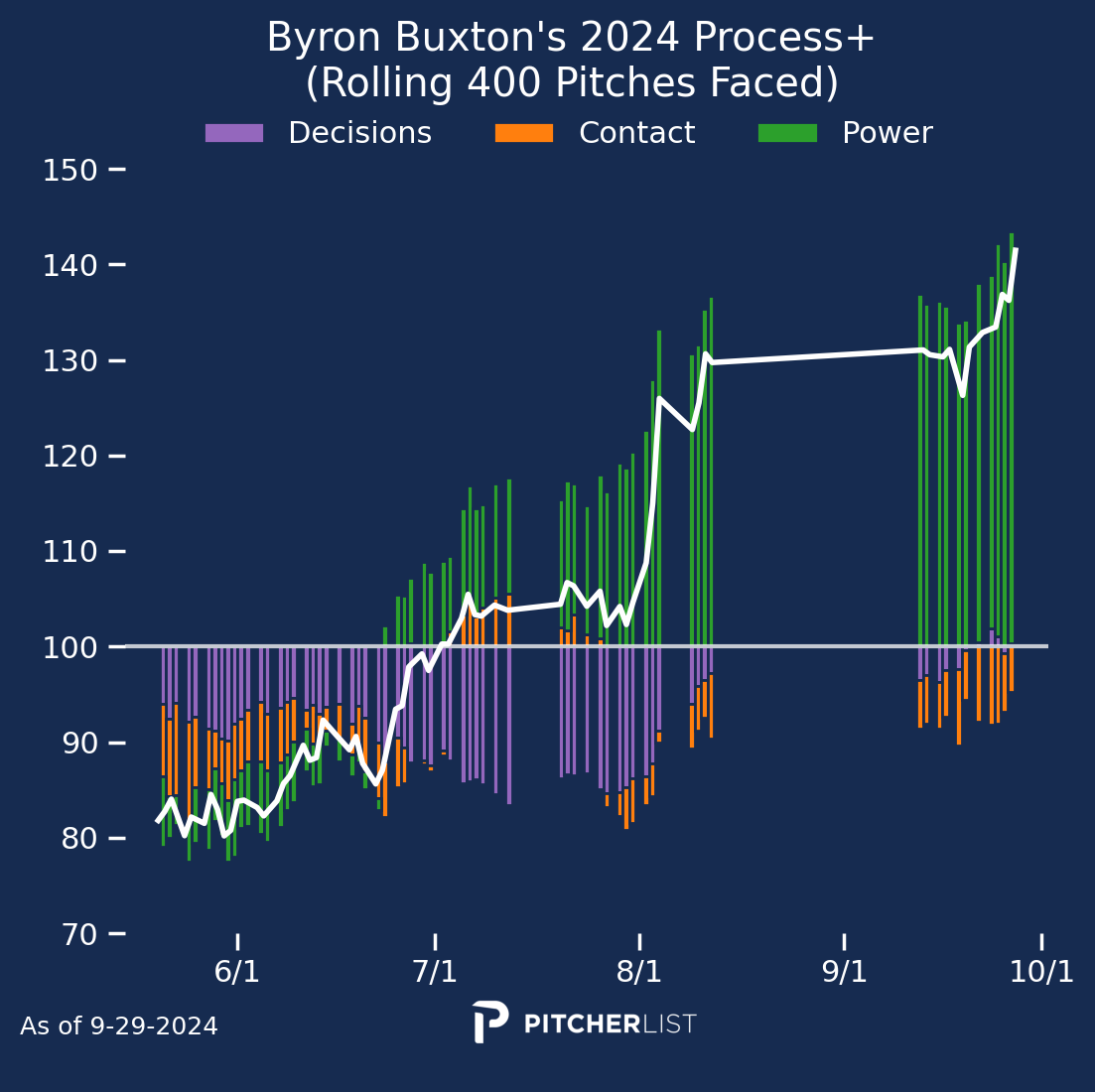
Buxton’s season wasn’t a league-winner for you, but given the price you likely paid for him, you got a pretty solid season when he was healthy.
Final season stats: 124.1 IP, 4.56 ERA, 1.34 WHIP, 22.2% strikeout rate, 7.9% walk rate
Kyle Harrison was definitely a name a lot of fantasy analysts were talking about during spring training, as he had put up some pretty good stats in what was admittedly a small sample size.
But even before spring training, we knew Harrison had good stuff, and when you’re looking for a dart throw pitcher at the end of a draft, I recommended looking for guys with good stuff they can build on as a foundation.
Harrison still flashed pretty good stuff during the season. The fastball came with good extension and really good HAVAA (though it came in a little slow at 92.6 MPH). The results against the pitch were fine, if unspectacular. Opposing hitters had a 40.9% ICR against the pitch (which isn’t great but is slightly better than average) and a .328 wOBA against it which, again, is fine and just slightly above average.
The curveball looked pretty nice too:
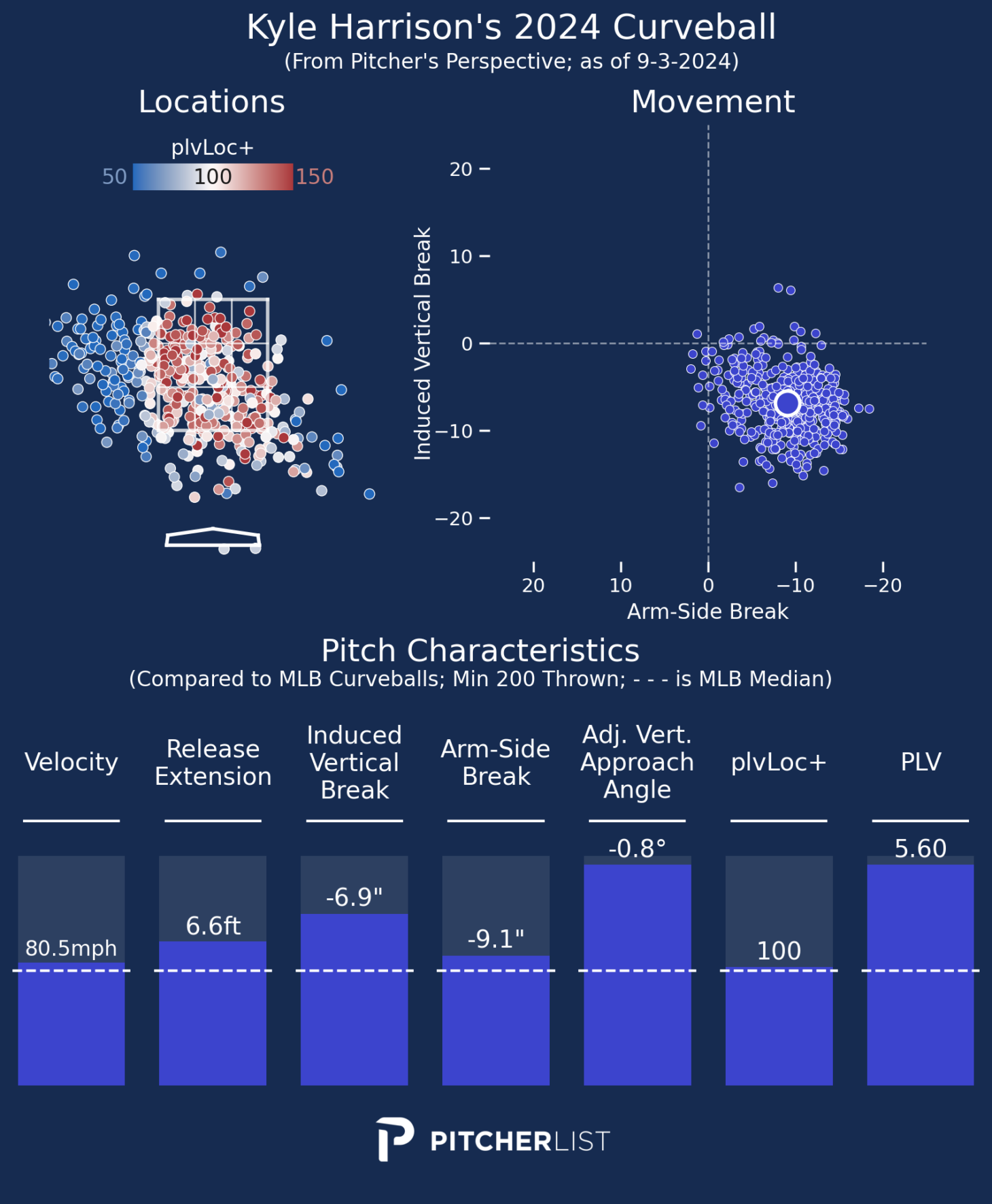
But while the curveball looked nice and it got knocked around a bit, with a 51% ICR against it (which is super high). And he didn’t use it as a strikeout pitch either, Harrison’s curveball was mainly a quick pitch to get in there in early counts.
Basically, Harrison is still a guy with plenty of raw talent but not someone who was able to consistently put it together during the season. If he got a bit more velocity on that fastball, that pitch could really pivot into something special, and paired with the curveball and a decent third pitch (the changeup isn’t it), Harrison could really do some cool stuff.
Certainly Harrison had his moments (his July start against Colorado where he pitched 6.2 innings with 11 strikeouts for example), but again he was never really consistent enough to help your team in a significant way and he was tough to trust out there.
Final season stats: 183.2 IP, 4.36 ERA, 1.12 WHIP, 23.1% strikeout rate, 6.7% walk rate
Kutter Crawford was another one of those guys who hadn’t turned in a great season just yet, but had the raw tools to turn one in this year (and had looked pretty darn good in spring training too).
And honestly, through the first half of the year, Crawford was looking like he was about to turn in a pretty great season (especially relative to where he was drafted), posting a 3.00 ERA with a 24.3% strikeout rate. But then the second half came along and that all fell apart, with Crawford posting a miserable 6.59 ERA with a 21.1% strikeout rate.
Some of that wasn’t on him—Crawford’s HR/FB rate jumped up from 9.7% in the first half to 18% in the second despite the fact he wasn’t giving up much harder contact in the second half (and an 18% HR/FB rate is pretty elevated anyways), but Crawford looked pretty rough in the second half.
Still, Crawford has the stuff to adjust and he’s going to be an interesting guy for the 2025 season. His fastball, while a bit slow, comes in with incredible vert at 19.2 iVB and loads of spin, and his kutter has a good bit of movement to it and posted an excellent 30.2% ICR. Very curious where he ends up going in drafts next year, but I’d argue that, despite the rough second half, Crawford still provided a good bit of value relative to where he was drafted.
Final season stats: .228/.301/.335, 8 HR, 38 R, 35 RBI
Boy oh boy did this one not work out at all.
Rizzo started off the 2024 season looking pretty good and then absolutely bombed the rest of the season until hitting the IL with a concussion. He still had the contact skills and he wasn’t all that far removed from a 32 home run season, so I figured why not take a shot on a bounceback season?
Well, that bounceback season wasn’t to be this year. Rizzo dealt with some injuries during the year, limiting him to 92 games (his fewest since 2012, not including the weird 2020 season). And while his contact skills were still decent, he was a black hole as far as power was concerned and he made poor decisions at the plate:

We’ll see what’s in store for Rizzo next year, assuming he can make it through a full season, but it’s not likely to be good given recent trends.
Final season stats: .244/.310/.433, 9 HR, 39 R, 28 RBI, 9 SB
Parker Meadows was a guy who I felt like had shown off some real potential during his brief time in the majors in 2023. He had 22 home runs and 27 steals in Triple-A that year and maintained a really solid walk rate in a brief stint up in the majors.
Unfortunately, Meadows got off to an extremely cold start to begin the year, slashing a miserable .100/.222/.229 in March and April before he was eventually demoted back down to Triple-A (though it’s worth noting he still maintained a 12.3% walk rate that month, which is encouraging).
Meadows was up and down between Triple-A and the majors a few times through May and July, but here’s where things get interesting—Meadows came back up in a more meaningful role in August and his second-half numbers are like a totally different person. Through August and September, Meadows hit .296/.340/.500 with six home runs and five steals.
And as he played through the last months of the season, his overall process got better:
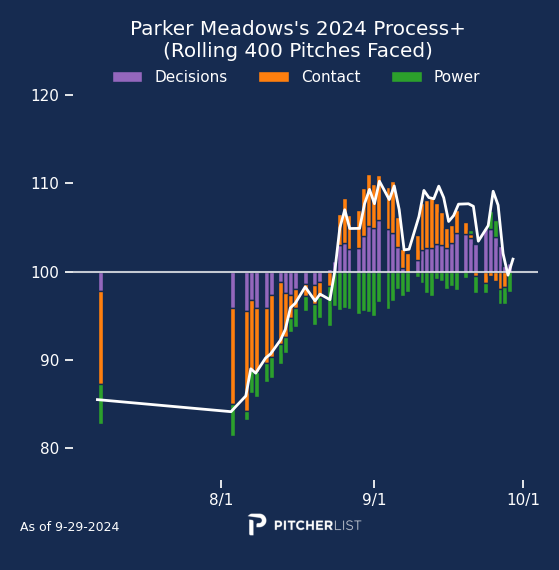
I think that talent is still there, and hopefully Meadows was able to help you in the second half of the season. I’m hopeful that Meadows will carry the success he had at the end of the year this year into next year—don’t be surprised if he ends up in my dart throws article again in March.
Final season stats: 109.2 IP, 4.10 ERA, 1.45 WHIP, 20% strikeout rate, 9.8% walk rate
Jordan Hicks has been one of the more GIF-able pitchers in the league for quite some time now, and last year after landing on the Giants, he was going to get the opportunity to be a starter, which was super intriguing. We all knew Hicks had the ability to succeed on the mound, the question was could he succeed as a starting pitcher?
The answer was…not really. He lasted as a starter until just after the All-Star Break and turned in mixed results. He started off the year pretty well, pitching to a 2.70 ERA through May, but then the wheels started to come off and from that point on he pitched to a 6.37 ERA until he was moved into the bullpen in late July. And on top of all of that, even when he was pitching well, he only went beyond five innings twice and the strikeouts weren’t all that enticing.
The sinker was still a good pitch from a pure stuff perspective, showing good velocity (as usual) and great break, but still it got knocked around a bit to the tune of a 43.5% ICR and a .393 wOBA against. The sweeper worked fairly well, posting a solid 15.3% swinging-strike rate and a very good 28.8% ICR, but outside of that, Hicks’s repertoire wasn’t much to write home about as a starter.
It’s doubtful he’ll get another shot in the rotation next year—we’ll see how effective he can be out of the bullpen in the future. But hopefully you rode his success in the early part of the year!
Final season stats: .260/.309/.380, 13 HR, 54 R, 61 RBI, 7 SB
Coming into 2024, Colt Keith was another one of those guys who was a prospect with a high pedigree who performed really well in the minors and looked to be slated to be an everyday player for the Tigers. So naturally, high-talent and opportunity means he was worthy of a shot late in drafts.
Ultimately, Keith was…fine. Not someone you were probably using with any regularity in 12-team leagues or shallower (probably not even in 14-team leagues unless you were desperate). I give the Tigers a lot of credit for keeping him out there for the entire season, given he was 1. not performing exceptionally well at the plate and 2. was basically a defensive liability at second base (a -8 DRS is…bad).
Keith’s season was a real rollercoaster ride from an offensive perspective. There were times when he was killing it, like in May when he hit .342/.388/.493 or July when he hit .322/.404/.644 and some times when he was miserable, like June when he hit .220/.238/.329.
You can see the ride here:
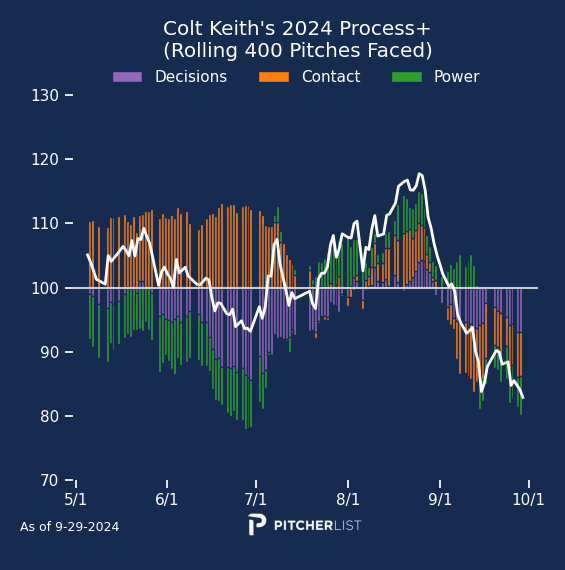
He was all over the place. But what that season says to me is that Keith has the talent to be a good player at the Major League level, and to be a useful fantasy asset. We saw it in flashes periodically, the skills are there, he just has to work on being more consistent (which, I mean, what rookie doesn’t?). That makes me hopeful for what Keith could do next year—he’s almost definitely going to have the opportunity, and hopefully he can seize it.
Final season stats: 43 IP, 5.02 ERA, 1.60 WHIP, 22.3% strikeout rate, 10.7% walk rate
Coming over as one of the main pieces in the trade that sent Corbin Burnes to Baltimore, DL Hall has long been one of those young pitchers who has filthy stuff but could never quite put it all together. In Baltimore, he never really had a consistent shot in the rotation, so the thought here was, the Brewers sent Corbin Burnes in a trade for him, they must want him and want him to be a starter. Always take a shot on raw talent late in drafts, right?
Well that didn’t exactly work out. Hall started off in the rotation with pretty poor results until he went on the IL with a knee injury in April and didn’t appear again until August, where he looked pretty decent for a couple of starts before being demoted to the bullpen for the rest of the year (aside from one spot start in September).
Hall struggled with control yet again, as he has for much of his career, posting a rough 10.7% walk rate on the year alongside a middling 22.3% strikeout rate. The velocity on his fastball was down a couple of ticks, likely due in part to him being in the rotation rather than the bullpen (though I’d still prefer to see him throwing at least 95 instead of 93) but he still had good extension and good HAVAA on the pitch. Regardless, the fastball got hit a bunch, to the tune of a .451 wOBA against.
The changeup worked better, with a 24.4% CSW and 34.5% ICR, but one pitch does not a pitcher make. Hall’s fastball was his most-thrown pitch and as we established, it got rocked, and his secondaries were not good enough to make up for it. Aside from the changeup, Hall threw a curveball that posted a solid 36.5% CSW and a middling 37.5% ICR, and his slider got destroyed to the tune of a 43.8% ICR.
Basically, Hall’s fastball wasn’t good, his slider was very bad, and his changeup and curveball were solid but not good enough to make up for his control issues and bad fastball.
We know Hall is talented, he’s shown flashes of that talent in the past. Hopefully he can make some adjustments, stay healthy, and turn things around next year.
Final season stats: 71.1 IP, 3.15 ERA, 1.11 WHIP, 3 saves, 14 holds, 29.9% strikeout rate, 9.5% walk rate
Hey that looks like a pretty good statline right? Looks like A.J. Puk did great!
Jk no not really. I mean, Puk did well this year, but not in the way I had hoped at the start of the season. The word was that Puk would become a starter for the Marlins, which was kind of exciting because Puk’s always had great stuff, so maybe he could turn into a solid starter similar to how Garrett Crochet did.
That was not to be. Puk started in four games with the Marlins to the tune of a 9.22 ERA and was immediately thrown back into the bullpen, never to see a start again.
And back in the bullpen, Puk thrived (including after he was traded to the Diamondbacks), pitching to a 1.72 ERA with a 35% strikeout rate. His fastball looked amazing, with good velocity coming in around 95-96 MPH on average, elite-level extension and very good HAVAA, and he paired that with an amazing slider that produced a ridiculous 25.8% swinging-strike rate.
So yeah, I guess the great A.J. Puk The Starting Pitcher experiment failed, but A.J. Puk The Reliever still works beautifully.
Final season stats: 177.1 IP, 3.30 ERA, 1.16 WHIP, 21.2% strikeout rate, 7.2% walk rate
This was a fun one! Coming into 2024, Erick Fedde hadn’t pitched in the Major Leagues since 2022, and he was very bad in 2022, pitching to a 5.81 ERA over 27 starts. Honestly, Fedde had never been especially good, never having a season with a sub-4 ERA, mediocre strikeout numbers, none of it was especially good.
But then Fedde went to the KBO in 2023 and changed his game, adding a new splitter, improving his slider, utilizing a cutter more often, and increasing the velocity on his fastball, and he ended up pitching to a 2.00 ERA with 203 strikeouts.
So coming into 2024, Fedde was kind of an interesting guy to take a shot on, see if maybe the changes from the KBO meant he could carry that success over to the U.S. And what’s really fun is, he did! Sure, Fedde didn’t get 200 strikeouts or a 2.00 ERA, but Fedde had a career-best year with the White Sox and then the Cardinals.
The strikeout numbers were okay, the walk numbers were okay, but he generally limited runs and provided plenty of value for your fantasy team as a result. Thanks to a nice cutter with good velocity and movement that could also get some swings and misses alongside a decent sweeper and a good changeup. And that new splitter he added showed up once or twice, and looked pretty good too, but it wasn’t a major part of his repertoire (though I’d like to see it a bit more personally, if he can command it well).
Of all the dart throws here, I think Fedde probably ended up giving you the best bang for your buck long-term.
Final season stats: 27.2 IP, 4.88 ERA, 1.55 WHIP, 18.7% strikeout rate, 9.8% walk rate
Unfortunately there isn’t a whole lot to say about Matt Manning’s 2024 season, because there wasn’t much of a 2024 season for him to have.
Manning has always been an interesting guy—he has a fastball with great extension, great induced vertical break, and great HAVAA, but pretty mediocre velocity. Still, that’s an intriguing fastball, and I love a guy who’s got a solid fastball to work with as part of his repertoire. The sweeper worked fairly well too, with a nice 33.3% CSW on it.
There’s still a nugget of a good pitcher here in Manning, I’m just hopeful that at some point in the future he’ll put it all together and be a great starter.
Final season stats: .252/.313/.417, 18 HR, 60 R, 64 RBI, 16 SB
The appeal of Jesús Sánchez coming into 2024 was his power. He posted an 11.8% barrel rate and 45.1% ICR in 2023, but because he made a lot of bad decisions at the plate, that power never really translated into success. But I figured, if you’re gonna take a swing on a guy late in drafts, might as well be someone who has shown they have the ability to crush the ball.
We saw a bit more power out of Sánchez this year than in previous years, but nothing crazy, and I think that was in part due to, again, bad decision-making at the plate:
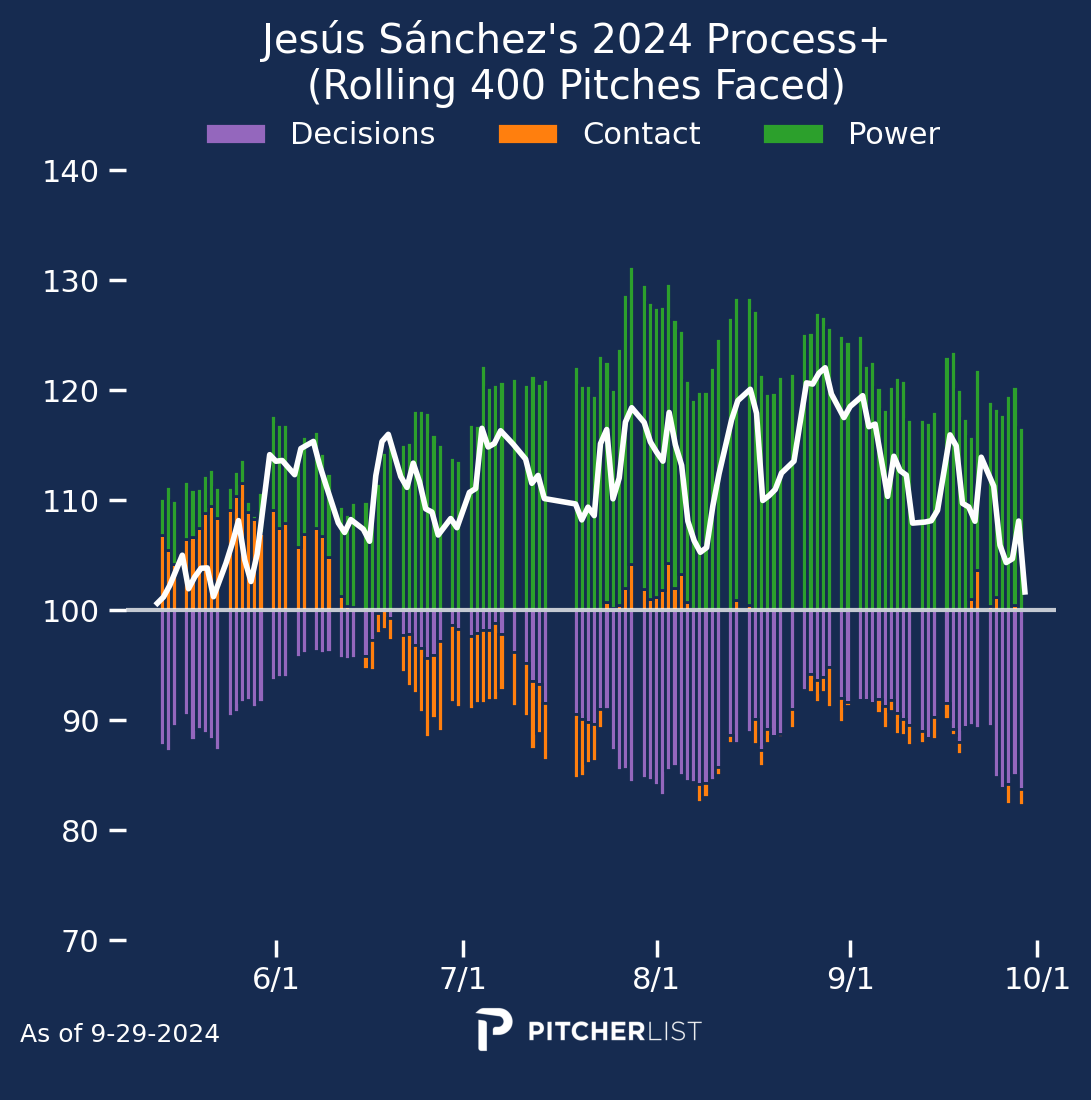
The raw power was there, and sure 18 home runs isn’t bad, but I still think there’s some untapped power potential that Sánchez has yet to tap into.
Still, a season where Sánchez hits 18 home runs with 16 steals while batting .252? That’s not a terrible season all in all and a useful player in deep leagues.
Final season stats: .098/.196/.098 in 17 games
The ceiling with Coby Mayo is very high, as we’ve seen during his time in Triple-A. The risk of drafting him this year was the Orioles just leaving him in Triple-A for another season to rake while they utilize other prospects up in the majors (thanks in part to Mayo breaking his rib during the season).
And that’s exactly what happened. Mayo only came up late in the year for a brief cup of coffee and spent the rest of the season down at Triple-A where he hit .287/.364/.562 in 89 games.
The ceiling is still very high for Mayo, and I’d imagine he’ll be a very popular sleeper coming into 2025. Of course, he comes with the risk that all rookies do of not doing great in the majors (we saw plenty of that from Jackson Holliday this season), but the talent is very much there.
Final season stats: 86.2 IP, 3.63 ERA, 1.18 WHIP, 21.8% strikeout rate, 6.5% walk rate
Ryan Weathers hadn’t had much major league success coming into this season, but he had made some tweaks (specifically increasing his fastball velocity and improving his slider) that made him seem interesting, as did his excellent spring training numbers.
Unfortunately Weathers missed a good bit of the season thanks to an index finger strain, but while he was out there, he actually looked pretty solid. His 3.63 ERA is a career-best by a mile, as was his 21.8% strikeout rate.
He did see his fastball velocity up a tick hovering around 96 MPH on average with good HAVAA and a good bit of horizontal movement on it. The changeup was really solid too, good at inducing weak contact while still getting some misses, with a good 29.9% CSW and a solid 33.3% ICR.
I’m very curious what Weathers’ season would’ve looked like without that injury. I think he was a fairly useful guy for your team while he was out there, and he’s definitely someone I’m going to be watching next year.
Photos Courtesy of Icon Sportswire | Designed by Aaron Asbury (@aarongifs on Instagram)

